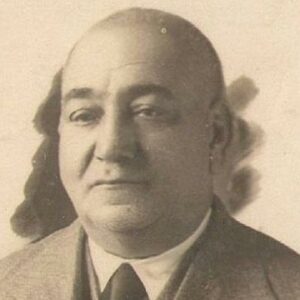Azim Azimzade was an Azerbaijani cartoonist and artist who established a reputation for himself in the field of satirical drawings and graphics with his exceptional caricatures and compositions. He received no formal education in the fine arts, but self-taught himself cartoon drawing and satirical graphics with the encouragement of renowned Russian artist Durov. Inspired by Azerbaijan’s traditions and customs, he chose to portray his country’s culture through everyday events such as poverty and misery, women’s rights, and social issues. He began publishing his cartoons in the ‘Molla Nasraddin’ newspaper, where he eventually became the chief artist. Additionally, his works have appeared in a variety of other Azeri periodicals, including ‘Baraban’, ‘Babayi-Amir’, ‘Mezeli’, and ‘Kelniyyet’. He created over 3,000 artworks over the course of his 35-year career, including caricatures, murals, drawings, illustrations, stage sets, costume designs, and posters. ‘Tight-Rope Walker’, ‘Dog Fight’, ‘Kos-Kosa’, ‘Old Baku’, ‘Division of Property’, ‘Husband Beating his Wife’, ‘A Daughter is Born’, ‘Trumped Cards’, ‘Face of Fascism’, ‘Watchdogs of Imperialism’, ‘Lion and Kitten’, ‘W He is the first artist to be named ‘People’s Artist of Azerbaijan SSR’.
Childhood & Adolescence
Azimzade was born Azim Aslan oglu Azimzade on May 7, 1880, in a Karbalayi Aslan family in Novkhani village, Absheron peninsula, near Baku.
His father, Aslan, was a stone cutter and farmer before transitioning to the oil industry when it began to boom. At the age of eight, he was admitted to a madrasa, a local Muslim school, but he began drawing instead of reciting his Quran lessons, which is considered a sinful act, and thus was beaten by his father.
With the assistance of his grandmother, he was enrolled in a Russian-Tatar school. However, as a result of his father’s pressure to find work, he only completed primary education and did not pursue further education.
He began working in a mill owned by Aghabala Guliyev at the age of 15, where he met Russian painter Durov, who encouraged him to study fine arts. However, due to a lack of funds, he was unable to obtain any formal education in the arts.
Career of Azim
He began freelancing in order to pursue a career in the arts and submitted his drawing ‘Irshad’s Client’ to the newly-founded Molla Nasraddin in 1906, founded by writer-democrat Jalil Mammadguluzadeh. The illustration was included in the magazine.
He continued to contribute to the magazine on a regular basis and began submitting his compositions to other Baku-based publications, including Baraban (Drum), Bij (Trickster), Mezeli (Funny), Kelniyyet, and Babayi-Amir.
During the 1920s and 1930s, he concentrated on caricatures and satirical drawings inspired by everyday events, but later expanded into other areas of fine arts, including book illustrations, stage design, and newspaper and magazine graphics.
In 1920, he was appointed director of the art department at the Republic’s Education Commissariat. In 1922, he was appointed chief artist of Communist, Azerbaijan’s most popular newspaper.
Molla Nasraddin magazine’s edition was renewed in 1922, which resulted in a fruitful collaboration between Mammadguluzadeh and Azimzade. He eventually rose to the position of chief artist at the magazine.
He was appointed chief artist of the State Theater in 1923, during the 50th Jubilee of Dramatic Works, and immediately began organizing set designs for numerous legendary works, including ‘Othello,’ ‘Nadir Shah,’ ‘Haji Gara,’ and ‘Leyli and Majnun.’
In the 1930s, he began exhibiting religious traditions and ancient Azerbaijani customs on canvas, which became his most lucrative period. ‘Tight-Rope Walker’, ‘Dog Fight’, ‘Kos-Kosa’, and ‘Old Baku’ were among his notable works.
His cartoons, which included ‘Wealthy Wedding’ and ‘Poor Wedding’ in 1931 and ‘Ramazan of the Rich’ and ‘Ramazan of the Poor’ in 1938, were a representation of culture, poverty, and societal issues confronting men and women.
He created drawings about women’s lives and rights, including ‘Division of Property’ (1935), ‘The Old Wife and the New Wife’ (1935), ‘Husband Beating his Wife’ (1937), and ‘A Daughter is Born’ (1937). (1937).
In 1937, he created the ‘100 Type’ series, a collection of ten horizontal drawings, each containing ten images, depicting the everyday man he encountered in Baku’s streets, markets, and offices.
He held his first exhibition in Baku in 1940, displaying approximately 1200 works created over a 35-year period. Following that, he organized exhibitions in Yerevan and Moscow.
‘Trumped Cards’, ‘Trophies of the Fuhrer’, ‘Shadows of Barbarians’, ‘Face of Fascism’, ‘Watchdogs of Imperialism’, ‘Lion and Kitten’, and ‘Wolf to Wolf’ were just a few of his outstanding drawings.
Significant Works of Azim
His 56 colored illustrations for Mirza Alakbar Sabir’s anthologies, titled ‘Hop-hop Name’ for the 1915 and 1922 editions, became one of his most enduring works.
Awards and Accomplishments
He was the first artist to receive the honorary title of ‘People’s Artist of the Azerbaijan Soviet Socialist Republic’ in 1927.
Personal & Professional Life
He collapsed and was unable to recover after his son, Latif, died in February 1943 during World War II. Following that, he suffered a heart attack and died four months later in Baku on June 15, 1943.
He was named after the Azerbaijan State Art School in Baku, which he directed from 1932 to 1937. His name is given to a street in Baku, and the first house museum in Azerbaijan, located on Dilara Aliyeva Street, is dedicated to his life and works.
Omar Eldarov, a renowned sculptor, created his monument in 2002 in Icheri Sheher, Baku, near Heydar Aliyev Palace.
Estimated Net Worth
The estimated net worth is $1-$5million.
Trivia
Sattar Bahlulzadeh, Maral Rahmanzadeh, Alekber Rzaguliyev, and Mikayil Abdullayev were among his famous students.


